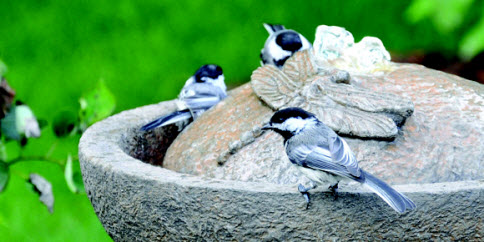At this time of year, our eyes and hearts are gladdened by the sight and sound of the chickadee.
These little grey, black and sometimes buff-coloured birds have a complex language. The number of dee notes in their call can indicate a nearby threat, how dangerous that threat is and even what predator is on the horizon.
The more dee notes, the more alarming the threat. Two dees might indicate a not-very-dangerous, roosting, great grey owl. Four notes-plus might indicate a very dangerous pygmy owl and the call turns to seets when the predator is on the wing. Fee-bee is something like, “Where are you, my dear?” Fighting chickadees snarl and will hiss when startled by a predator.
In the summer, chickadees love a good feed of insects, caterpillars, spiders and larvae, sweetened with berries and washed down with sunflower seeds. In the winter, they will flock to a suet feeder. Usually, they pick their food off the branches and trunks of trees, but have been known to catch the odd flying bug and will even hang upside down to get a particularly tasty morsel.
Chickadees often cache their food and remember quite vividly where to find it up to 28 days later. After that, their memory dims. In fact, their memory has a finite lifespan. Scientists say that, in fall, quite a number of their neurons die off, to be replaced by fresh ones that can retain a new stock of critical information to do with flock changes and environment. Talk about early senescence!
Chickadees will snap up the occasional sunflower seed. They will take this goody off to a secluded spot and use their short little bill to hammer it open and get at the oily morsel inside.
They have little fear of humans and can readily be induced to feed from a friendly hand. Hold out some unshelled sunflower seeds. Be very still and patient. Before too long, you may feel an air-light presence on your hand as a curious and tempted chickadee drops by for a handout.
When courting, and while she is laying and then brooding, Mr. chickadee brings her food and continues to look after her needs until she can leave the nest. Then they both feed the chicks for several weeks. Gradually, his support wanes, and she continues supplementing the feeding of the brood, even after the youngsters have left the nest and are learning to fend for themselves.
Although they mate for life, lady chickadees have been known to sneak off at dawn and find a lover who is higher on the social scale, mating outside the pair. Chickadees are quite hierarchical, with older male birds highest on the ladder. Younger, subdominant males can often be relegated to the outer branches of a foraging tree where there is more danger and where the pickings are slimmer.
They lay pretty eggs. The clutch of anywhere from five to nine eggs is white with brown speckles at the fat end. The nests are built in cavities, either recycled ones or cavities they helped create about 23 feet high in trees. They will come to the right-sized birdhouse, though, liking an entry hole of 1 1/8 inches in diameter.
Chickadees are no less territorial than other birds, but they will often attract a group of hangers-on from other species, such as nuthatches, woodpeckers, titmice and warblers, that will respond to the chickadee alarm call even though their own call may be quite different. Chickadees will also signal new food sources, to the benefit of their many varied companions.
While most birds huddle together for warmth in winter, chickadees are lonely little souls, preferring to nestle down with a head under a wing in their cavity homes when the north wind doth blow.



